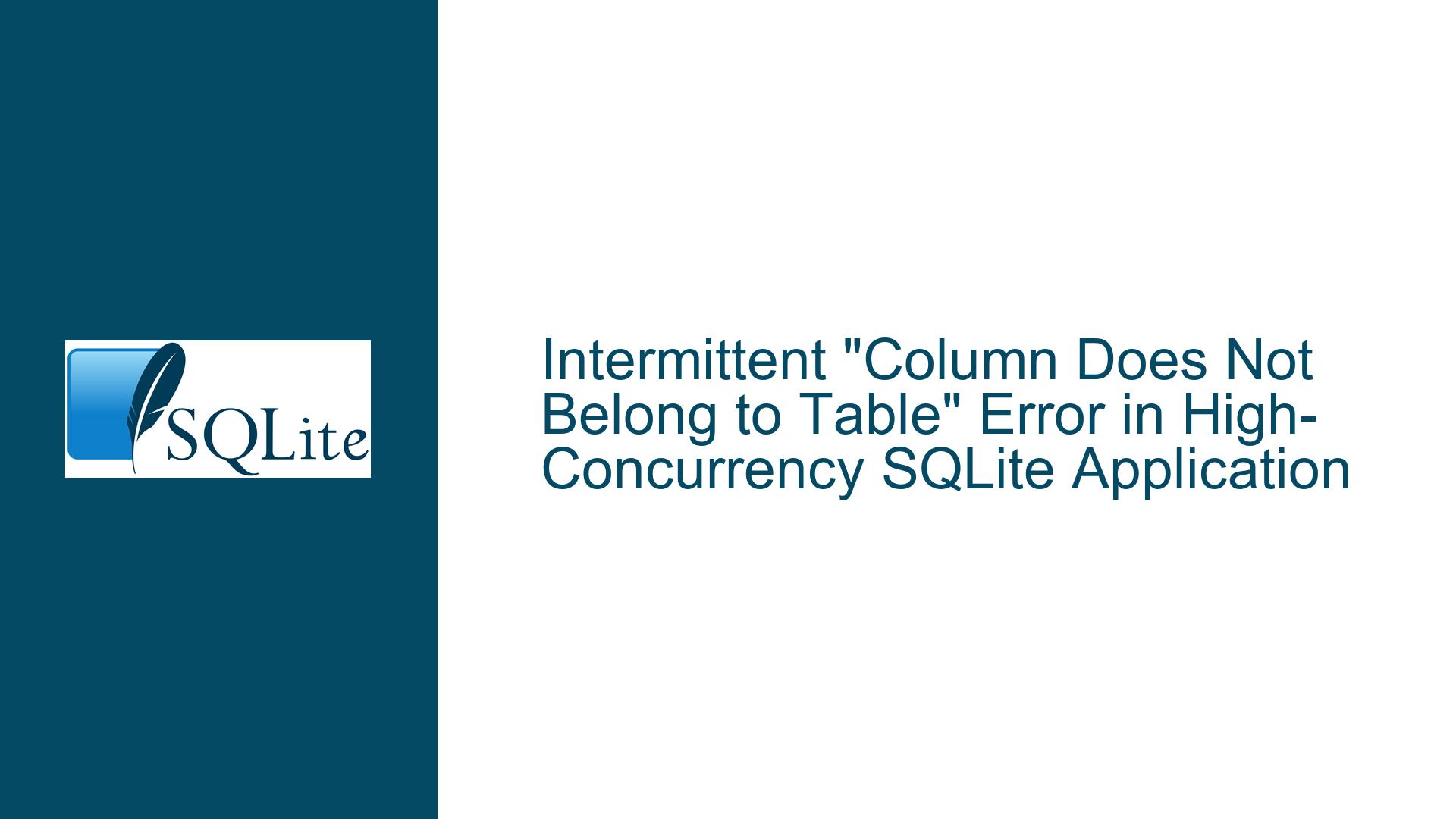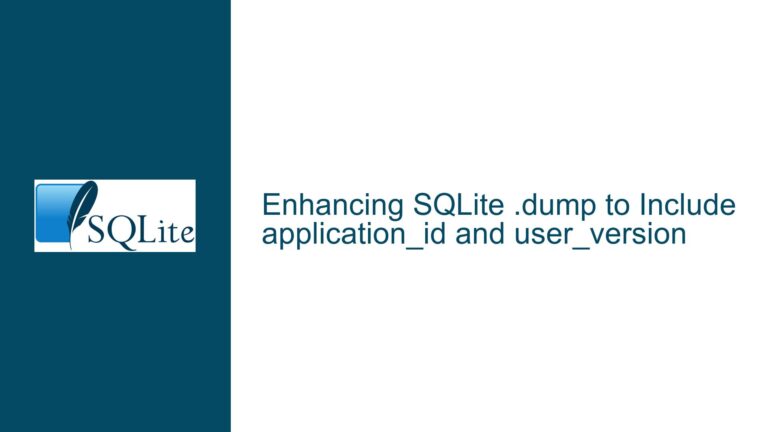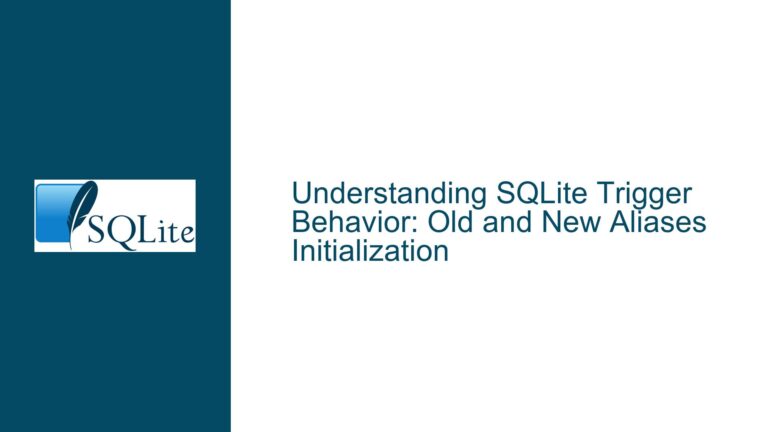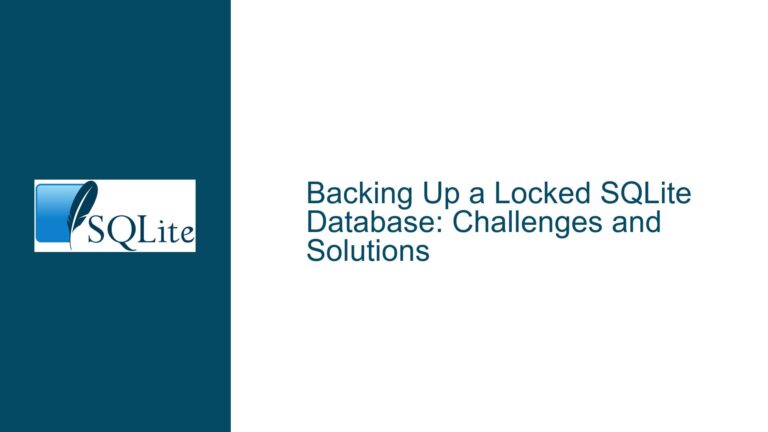Intermittent “Column Does Not Belong to Table” Error in High-Concurrency SQLite Application
Issue Overview: Intermittent Column Mismatch During High-Frequency Database Operations
The core issue reported involves an intermittent System.Data.SQLite.SQLiteException with the message "Column ‘ORD_SERIAL_NO’ does not belong to table" in a high-throughput C# application using SQLite 3.40.0. The application processes real-time trading data at rates of 300-400 trades per second, with frequent insertions and deletions. The error occurs sporadically (approximately 1 in 500 operations) when retrieving data from the ORDERS table using a SELECT query and attempting to access the ORD_SERIAL_NO column in a DataTable. A workaround involving exception handling and retries (GOTO statements) partially resolves the issue but does not eliminate it. The problem is exacerbated under high system load and stock market volatility.
Key observations:
- The
ORD_SERIAL_NOcolumn definitively exists in theORDERStable schema and is part of the primary key. - The failing query uses
SELECT *, and the error arises when accessing the column by name in theDataTable. - The application is multi-threaded and uses
System.Data.SQLitefor database operations. - Schema changes are not explicitly performed at runtime, but the error suggests a transient mismatch between the application’s expectation of the schema and SQLite’s internal state.
Possible Causes: Concurrency, Schema Caching, and Data Handling Flaws
1. Thread Contention and Connection Management
SQLite serializes write operations by default, but concurrent reads are allowed. In multi-threaded scenarios:
- Unsafe Connection Sharing: If multiple threads share the same
SQLiteConnectionwithout proper synchronization, schema metadata cached by the connection may become inconsistent. - Isolation Level Conflicts: Long-running transactions or
READ UNCOMMITTEDisolation levels might cause threads to observe partial schema changes or stale data. - Locking Conflicts: Heavy write operations (inserts/deletes) can trigger
SQLITE_BUSYerrors, leading to transient failures in schema metadata retrieval.
2. Schema Metadata Caching Issues
The System.Data.SQLite provider caches schema information for performance. Under high concurrency:
- Stale Schema Cache: If the schema is altered (even implicitly via
VACUUMorANALYZE), cached metadata in the provider may not refresh promptly. - Dynamic Query Construction: Using
SELECT *forces the provider to resolve column names at execution time. If the table is locked or modified during query execution, the resolved columns may mismatch theDataTable’s expected schema.
3. DataTable Column Mapping Errors
The DataTable schema is inferred when SQLiteDataAdapter.Fill() is called. Potential flaws include:
- Race Conditions in DataTable Initialization: If multiple threads modify the same
DataTableinstance, column mappings may be overwritten or corrupted. - Case Sensitivity Mismatches: Column names like
ORD_SERIAL_NOmay be referenced with incorrect casing in code (e.g.,ord_serial_no), though SQLite is case-insensitive by default. - Column Ordinal Shifts: If the
SELECT *result’s column order changes due to schema alterations, accessing columns by index (e.g.,Rows[0][3]) instead of name could fail.
4. SQLite Configuration and System.Data.SQLite Bugs
- Legacy Schema Format: SQLite’s
legacy_file_formatpragma, if enabled, may cause compatibility issues with modern schema definitions. - Outdated System.Data.SQLite Library: Older versions of the C# provider have known bugs related to schema caching and multi-threading.
Troubleshooting Steps, Solutions, and Fixes
1. Eliminate SELECT * and Use Explicit Column Lists
Problem: SELECT * dynamically resolves columns at execution time, risking schema mismatches if metadata changes during high concurrency.
Solution:
Rewrite the query to explicitly list columns:
SELECT
ORD_ORDER_NO, ORD_SERIAL_NO, ORD_SEM_SMST_SECURITY_ID, ...
FROM ORDERS
WHERE ...
Benefits:
- Eliminates dependency on schema caching.
- Ensures the
DataTablealways contains the expected columns. - Improves performance by reducing data transfer.
2. Enforce Thread-Safe Database Access
Problem: Multi-threaded access to shared connections or DataTable instances can corrupt metadata.
Solutions:
A. Use Dedicated Connections Per Thread
// Create a new connection for each thread
using (var conn = new SQLiteConnection(connectionString))
{
conn.Open();
// Execute queries within this thread
}
B. Serialize Access with a Mutex
private static readonly object _dbLock = new object();
lock (_dbLock)
{
using (var adapter = new SQLiteDataAdapter(query, connection))
{
adapter.Fill(dataTable);
}
}
C. Configure SQLite for Multi-Threaded Mode
Ensure the connection string includes:
"Data Source=...;Version=3;Pooling=False;"
3. Validate Schema Metadata Refresh
Problem: The System.Data.SQLite provider may cache stale schema information.
Solutions:
A. Disable Schema Caching
using (var cmd = new SQLiteCommand("PRAGMA schema.synchronous = FULL;", connection))
{
cmd.ExecuteNonQuery();
}
B. Explicitly Refresh Schemas
After structural changes:
connection.Close();
connection.Open(); // Forces schema cache reload
4. Debug Column Mapping in DataTable
Problem: The DataTable may lack the ORD_SERIAL_NO column due to initialization errors.
Solutions:
A. Verify Column Existence Before Access
if (dtOrdDtls.Columns.Contains(clsConstantsEnums.gstrConstORD_SERIAL_NO))
{
// Access column
}
else
{
// Log schema mismatch
}
B. Use Strongly-Typed DataSets
Generate a typed DataSet from the schema to avoid runtime column name resolution.
5. Inspect for Implicit Schema Changes
Problem: Auto-vacuum, index rebuilds, or other background operations may alter schema metadata.
Solutions:
A. Disable Auto-Vacuum
PRAGMA auto_vacuum = 0; -- Disables automatic vacuuming
B. Audit All Database Operations
Log all CREATE, ALTER, and DROP statements to identify unintended schema changes.
6. Update SQLite and System.Data.SQLite
Problem: Bugs in older SQLite versions or C# providers may cause intermittent failures.
Solutions:
- Upgrade to SQLite 3.45.1+ (fixes concurrency bugs).
- Use the latest
System.Data.SQLiteNuGet package (1.0.118+).
7. Enable Detailed Logging and Diagnostics
Problem: Insufficient logging masks root causes.
Solutions:
A. Capture SQLite Diagnostic Messages
SQLiteLog.Initialize(); // Enable internal logging
SQLiteLog.Log += (sender, args) =>
{
File.AppendAllText("sqlite.log", $"{args.Message}\n");
};
B. Log Thread IDs and Timestamps
Augment logs with thread context to identify race conditions:
Debug.WriteLine($"[Thread {Thread.CurrentThread.ManagedThreadId}] Filled DataTable at {DateTime.UtcNow:O}");
8. Reproduce the Issue in a Controlled Environment
Problem: Sporadic errors are difficult to debug in production.
Solutions:
A. Simulate High Concurrency
Use a load-testing tool like BenchmarkDotNet to replicate 400+ TPS:
[Benchmark]
public void SimulateTradeInserts()
{
Parallel.For(0, 500, i =>
{
InsertOrderWithSerialNo();
});
}
B. Attach a Debugger During Failures
Configure Visual Studio to break on System.Data.SQLite.SQLiteException and inspect the DataTable’s columns.
9. Review Schema Design and Data Types
Problem: Suboptimal data types (e.g., DOUBLE for order numbers) may cause side effects.
Solutions:
A. Use INTEGER for Primary Keys
Redefine ORD_ORDER_NO and ORD_SERIAL_NO as INTEGER to avoid rounding errors.
B. Remove Redundant Columns
Drop ORD_Reserved and other unused columns to simplify the schema.
10. Utilize SQLite’s Exclusive Locking Mode
Problem: Concurrent writes may starve reader threads.
Solution:
Open the database in exclusive mode during peak loads:
var connectionString = "Data Source=...;Mode=Exclusive;";
By systematically addressing concurrency, schema caching, and data handling practices, the intermittent column mismatch error can be resolved. Implement these fixes in a staging environment under simulated load before deploying to production.






